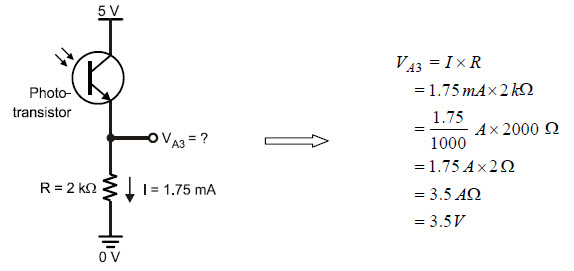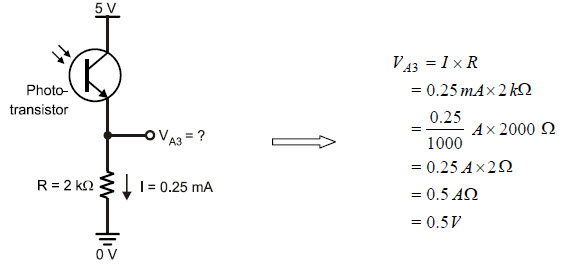Two properties affect the voltage at VA3: current and resistance, and Ohm’s Law explains how it works. Ohm’s Law states that the voltage (V) across a resistor is equal to the current (I) passing through it multiplied by its resistance (R). So, if you know two of these values, you can use the Ohm’s Law equation to calculate the third:

In some textbooks, you will see E = I × R instead. E stands for electric potential, which is another way to say “volts."
Voltage (V) is measured in units of volts, which are abbreviated with an upper-case V. Current (I) is measured in amperes, or amps, which are abbreviated A. Resistance (R) is measured in ohms which is abbreviated with the Greek letter omega (Ω). The current levels you are likely to see through this circuit are in milliamps (mA). The lower-case m indicates that it’s a measurement of thousandths of amps. Similarly, the lower-case k in kΩ indicates that the measurement is in thousands of ohms.
Let’s use Ohm’s Law to calculate VA3 in with the phototransistor, letting two different amounts of current flow through the circuit:
- 1.75 mA, which might happen as a result of fairly bright light
- 0.25 mA, which would happen with less bright light
The examples below show the conditions and their solutions. When you try these calculations, remember that milli (m) is thousandths and kilo (k) is thousands when you substitute the numbers into Ohm’s Law.
Example 1: I = 1.75 mA and R = 2 kΩ

Example 2: 1 = 0.25 mA and R = 2 kΩ

Your Turn – Ohm’s Law and Resistor Adjustments
Let’s say that the ambient light in your room is twice as bright as the light that resulted in VA3 = 3.5 V for bright light and 0.5 V for shade. Another situation that could cause higher current is if the ambient light is a stronger source of infrared. In either case, the phototransistor could allow twice as much current to flow through the circuit, which could lead to measurement difficulties.
Question: What could you do to bring the circuit’s voltage response back down to 3.5 V for bright light and 0.5 V for dim?
Answer: Cut the resistor value in half; make it 1 kΩ instead of 2 kΩ.
- Try repeating the Ohm’s Law calculations with R = 1 kΩ, and bright current I = 3.5 mA and dim current I = 0.5 mA. Does it bring VA3 back to 3.5 V for bright light and 0.5 V for dim light with twice the current? (It should; if it didn’t for you, check your calculations.)
